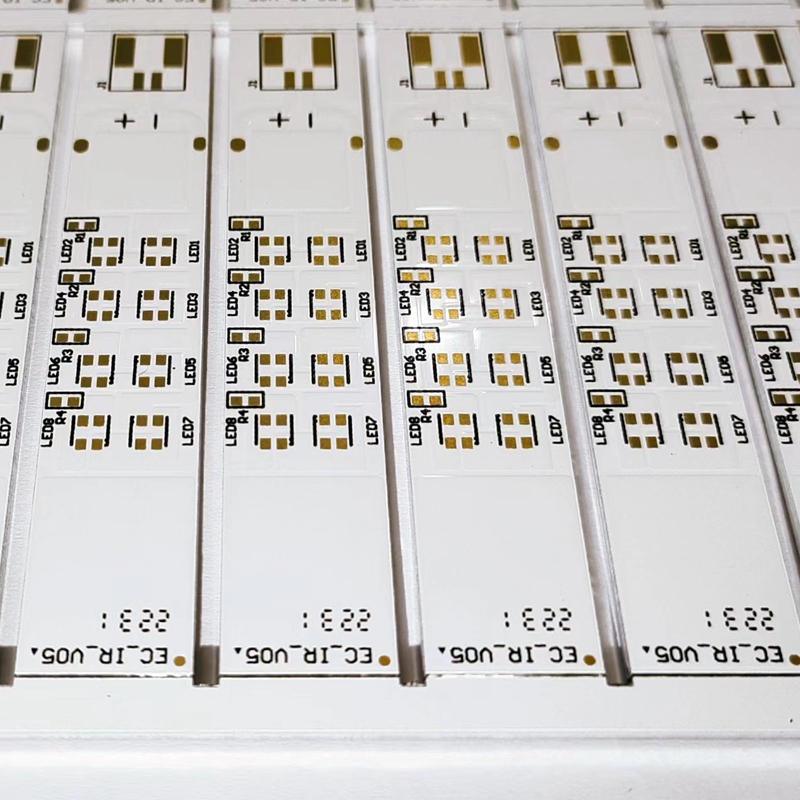Comparison of High Thermal Conductivity Aluminum PCB and Copper-Based PCB
High thermal conductivity aluminum PCB and copper-based PCB are two common choices for PCB. Each material has unique properties and is suitable for various applications. In this article, we will compare and contrast the features, advantages, and disadvantages of these two types of PCBs to help PCB designers make the right and appropriate design decisions.
Characteristics of high thermal conductivity aluminum PCB
High thermal conductivity aluminum PCBs have excellent thermal conductivity, effectively dissipating heat generated by electronic components such as power semiconductors and LEDs. Secondly, high thermal conductivity aluminum pcbs have good mechanical properties, including increased strength and stiffness. At the same time, they can withstand the mechanical stress and vibration encountered during operation, ensuring long-term reliability and durability. In addition, aluminum substrates are lightweight compared to traditional ceramic substrates, making them ideal for applications where weight reduction is essential, such as aerospace and automotive electronics. Their low density helps reduce overall system weight without compromising performance.

Advantages of copper-based PCBs
The high conductivity of copper-based PCB ensures effective signal transmission and significantly reduces power loss, thus improving the overall performance of electronic devices. Compared to other materials, such as aluminum or FR-4, copper has higher electrical conductivity, allowing for better signal transmission and lower resistance in electronic circuits. Copper-based PCBs are also known for their high mechanical strength and durability. They can withstand harsh working conditions and are less prone to warping or deformation than aluminum PCBs. Additionally, copper-based PCBs are compatible with various surface treatments and soldering techniques, making them suitable for assembly processes.

High thermal conductivity aluminum PCB thermal conductivity comparison
Highly thermally conductive aluminum PCBs typically have a thermal conductivity of 1.0 to 2.0 W/mK. Although aluminum is an excellent conductor of heat, its thermal conductivity is lower than copper. However, aluminum PCBs offer advantages such as lightweight design, cost-effectiveness, and compatibility with manufacturing processes. On the other hand, copper-based PCBs have significantly higher thermal conductivity, typically ranging from 1.5 to 4.0 W/mK. Copper is known for its excellent thermal conductivity, making copper-based PCBs very effective at dissipating heat generated by electronic components. This superior heat dissipation capability is particularly beneficial in high-power applications, where efficient thermal management is critical to maintaining optimal performance and reliability.

Cost considerations
High thermal conductivity aluminum PCBs are often a more cost-effective solution compared to copper-based PCBs. Aluminum typically has lower raw material costs than copper, thus reducing the material cost of aluminum PCBs. Additionally, aluminum PCBs have a less complex manufacturing process and require fewer steps than copper-based PCBs, reducing production costs. While they offer lower upfront costs, highly thermally conductive aluminum PCBs may require additional surface treatments or coatings to prevent oxidation and ensure solderability, which can increase overall production costs. Additionally, they may have mechanical strength and durability limitations compared to copper-based PCBs, resulting in higher failure rates and maintenance costs.
Copper-based PCBs generally require higher initial material costs, so the cost of copper-based PCBs is higher. Additionally, the manufacturing process for copper-based PCBs can be more complex and time-consuming than aluminum PCBs, resulting in higher production costs. However, copper-based PCBs offer several advantages, and their superior thermal conductivity allows for more efficient heat dissipation, reducing the need for additional thermal management components such as heat sinks or thermal pads. This saves overall costs in component selection and system design.
Design flexibility and compatibility comparison
Highly thermally conductive aluminum PCBs offer design flexibility due to their lightweight nature. Aluminum is a malleable material that allows the creation of complex circuit designs with precise patterns and functions. Additionally, aluminum PCBs can be manufactured using processes such as etching and drilling, making them ideal for intricate designs and high-density circuitry. On the other hand, copper-based PCBs offer excellent design flexibility and compatibility with various electronic components and manufacturing processes. Copper is highly versatile and easily integrated into multiple circuit designs, supporting simple and complex layouts. Additionally, copper-based PCBs are compatible with standard PCB manufacturing techniques such as electroplating, soldering, and SMT.
Ultimately
This guide clarifies that highly thermally conductive aluminum and copper-based PCBs have unique advantages and disadvantages. When choosing between the two, thermal management needs, electrical conductivity, mechanical strength, cost, and design flexibility must be considered. Factor. If thermal management is a primary concern, a highly thermally conductive aluminum PCB may be the ideal choice. A copper-based PCB may be suitable if signal integrity, durability, or design complexity are vital factors.


